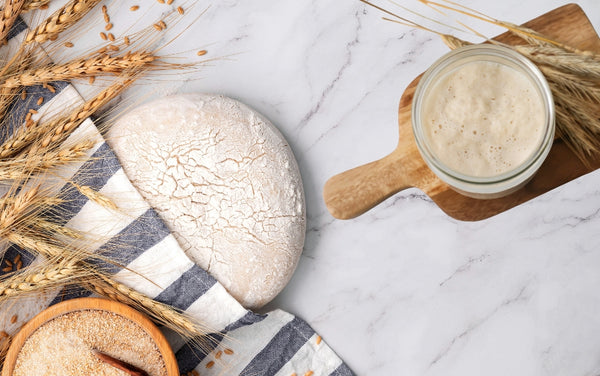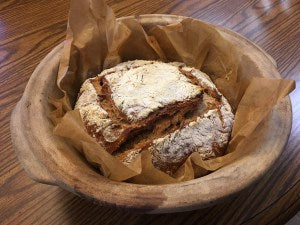Sourdough bread making is a valuable skill for emergency preparedness. It is a way to ensure that you have access to a nutritious and shelf-stable food source, even if commercial yeast is not available. It is also a skill that you can share with others and use to help your community in times of need.
A Tale of TP and Sourdough During the Pandemic in Utah
In a state like Utah, where so many homes store food for emergencies, I was surprised the day our Governor declared the pandemic emergency when there was a rush to stock up at grocery stores. That day, shelves cleared off fast and there were long lines at checkout.

At our home we had plenty of food and TP in storage, but since it was our normal shopping day I headed out to the grocery store not realizing what was taking place there. I shopped for some fresh produce and then I walked around the store to see what was going happening.
In the 30 minutes after I had arrived, shelves were stripped of flour and yeast and many other supplies. Happily, I got the last rolls of toilet paper but then had to stand in line for 90 minutes to check out with that TP and other groceries.
On the drive home I thought about our food storage and vowed not to return to the mess I had just witnessed until the pandemic was over. Little did I know it would take months for things to return to normal.
I wasn't worried thought, there was enough food in storage to last for weeks and there was wheat for year. Happily I had the starter Martha Levie had given us as part of a free sourdough bread class offered by Abigail's Oven a few years prior to the pandemic. Together these things left me with a secure feeling moving through the pandemic.

The Case for Sourdough Bread Making in Times of Disaster
There are several reasons why sourdough bread making skills are important for emergency preparedness:
- Sourdough bread is shelf-stable. Sourdough bread can last for weeks or even months at room temperature without spoiling. This is because the lactic acid bacteria in the sourdough starter produce a preservative effect.
- Sourdough bread is nutrient-rich. Sourdough bread is a good source of protein, fiber, B vitamins, and iron. It is also more easily digestible than other types of bread.
- Sourdough bread can be made without commercial yeast. Commercial yeast may not be available in an emergency, but sourdough bread can be made using only flour, water, and salt.
- Sourdough bread making is a relatively easy skill to learn. Even beginners can learn to make sourdough bread with a little practice.
In addition to these benefits, sourdough bread making can also be a source of comfort and stress relief during an emergency. The process of baking sourdough bread is meditative and can help to take your mind off of your worries. And of course, there's nothing quite like the smell of fresh-baked bread to lift your spirits.
Education as Part of Emergency Preparation
"Bread is the staff of life. It is the one food that is essential for human existence."—George Washington Carver, American agricultural scientist, 1914
In any serious emergency REAL™ sourdough bread can be the staff of life. But it is important to learn how to use whole grain to make a good loaf and when there is no commercial yeast in the stores and neither flour nor wheat left on the shelves, its a little late to learn how to make Sourdough Bread.
My sourdough journey began five years ago in a class taught by Martha, Abigail's mother. In just 75 minutes, she showed us 7 Simple Steps for making our first loaf of sourdough. She also explained how to care for and feed the starter that she gave us during class.

My first few loaves where not lovely, but very serviceable. They tasted really good and the cumb was surprisingly even.
Martha still offers these free sourdough bread classes at The Store at the Bakery, usually several times a month. Those who participate learn to make sourdough in their own homes.
However, these days you have the choice to attend in person (Abigail's Oven is located at 421 South 200 East in Spanish Fork, UT) or via Zoom anywhere in the world.
Storage as Part of Emergency Preparation
Of course, this kind of preparation takes time. Our first wheat made its way into the basement of our home nearly 50 years ago. As our family grew, we added more, along with salt, water, and other supplies.
I still use that wheat for bread making, and it makes great tasting sourdough bread. The key to storing wheat for long periods of time is to keep it in a cool, dry place. Wheat should be stored in airtight containers to prevent pests from getting in and to keep the grain fresh.
Here are some specific examples of studies that show that long-term storage of wheat does not diminish the nutritional value of the grain:
- A study published in the journal Cereal Chemistry in 1999 found that wheat stored for up to 30 years retained its nutritional value, including its protein, fiber, and vitamin content. The study also found that the baking quality of the wheat remained good after 30 years of storage.
- In Preserve the Harvest, Utah State University (USU), recommended: "A good rule of thumb is to rotate wheat so that no stored product is older than 5 years." However they reported a Brigham Young University "study indicated that, regardless of headspace oxygen level, wheat packaged in No. 10 cans throughout 32 years of storage at ambient or cooler temperatures made bread acceptable to a majority of consumers."
- A study published in Journal of Stored Products Research in 2013 found that wheat stored for up to 10 years retained its nutritional value, including its protein, fiber, and vitamin content. The study also found that the baking quality of the wheat remained good after 10 years of storage.
While these studies show that wheat can be stored for long periods of time without losing its nutritional value, as part of that class, Martha explained how the wheat many of us have in storage might actually harm our gut and the rob nutrition whole grain bread promises.
The culprit on whole wheat is phytic acid that remains when commercial bread is made quickly. She explained that in sourdough, since the fermentation time is between 8 and 72 hours, most of the phytic acid is mitigated making the vitamins and minerals found in wheat readily bioavailable.
You can register for our next free class on Wednesday, November 8, at 5:30 pm MST by clicking here (https://www.eventbrite.com/cc/sourdough-classes-1324809) and you can look for future classes here (https://abigailsoven.com/pages/bread-classes)

Overall, sourdough bread making is a valuable skill for emergency preparedness. It is a way to ensure that you have access to a nutritious and shelf-stable food source, even if commercial yeast is not available. It is also a skill that you can share with others and use to help your community in times of need.

Author: Darryl Alder lives with his wife at our Riverside Lodge along the Provo River. Together they have raised 4 adopted children and now have 6 grandchildren that keep them busy. After retiring from a career with the Boy Scouts of America, he became a hobby sourdough baker and blogger. He continues to blog for AbigailOven.com and other companies. You can follow him via gmail@darrylhalder, Facebook Messenger, Instagram @darryl.alder, and X @DarrylHAlder.

